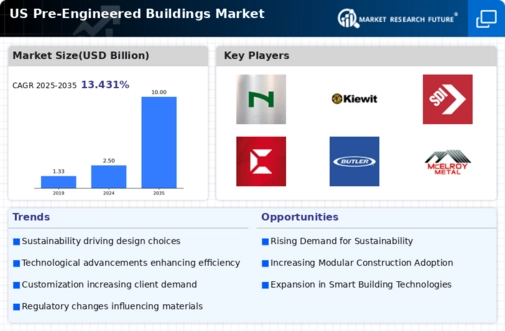The US Pre-Engineered Buildings Market has witnessed significant growth and innovation in recent years, driven by increasing demand for cost-effective and sustainable construction solutions. This market segment comprises a diverse range of prefabricated structures designed for various applications, including industrial, commercial, and agricultural purposes. Numerous players are engaged in this competitive landscape, contributing to advancements in design, materials, and technology. The unique needs of the construction industry, paired with a push for faster project completion times and eco-friendly practices, have led companies to refine their offerings and enhance their market positions.
The competitive dynamics often reflect a blend of traditional manufacturing practices and modern technological integration, presenting both opportunities and challenges for stakeholders striving to maintain relevance and profitability in this sector.Ceco Building Systems is a prominent player within the US Pre-Engineered Buildings Market, known for its extensive portfolio and commitment to delivering high-quality building solutions. The company's strength lies in its ability to provide custom-engineered buildings that cater specifically to client requirements while adhering to industry standards. Ceco’s reputation is well-established across various sectors, including commercial and industrial applications, due to its focus on innovation and customer satisfaction.
Furthermore, its strong distribution network within the United States facilitates effective market presence and engagement with clients, allowing for timely project execution and responsive service delivery. Ceco Building Systems continually invests in technology and research, ensuring that its products align with evolving construction trends and sustainability standards, thus solidifying its competitive edge in the marketplace.Nucor stands out as a major player in the US Pre-Engineered Buildings Market, leveraging its vast resources and research capabilities to offer a wide range of steel products and structural components.
Nucor specializes in innovative building solutions, including metal buildings that are designed to meet the specific needs of various industries. The company’s strengths lie in its robust manufacturing infrastructure and an integrated supply chain, allowing for efficient production and delivery of pre-engineered structures. Nucor has established a significant market presence owing to its strategic mergers and acquisitions, enhancing its capabilities and expanding its product offerings. Through a commitment to sustainability and environmental responsibility, Nucor has gained recognition for its energy-efficient buildings, making it a preferred choice among clients focused on eco-friendly construction solutions.
This strong emphasis on innovation and quality, combined with a responsive customer service approach, positions Nucor as a leading competitor in the US Pre-Engineered Buildings Market.

















Leave a Comment